With a disappointing fourth place in last year’s league campaign, AC Milan were pushed to improve their squad, and in this precise transfer window, they spent around €110.50m. Generally, in a 4-2-3-1 system, AC Milan’s head coach Stefano Pioli had two big tasks: replace Sandro Tonali and Brahim Díaz’s departures.
Tonali’s departure significantly reinforced AC Milan’s midfield with players like Ruben Loftus-Cheek from Chelsea FC, Yunus Musah from Valencia and even Tiffani Reijnders from AZ Alkmaar. Besides that, another reason for Milan to sign three midfielders could have been Ismaël Bennacer’s injury, which can let the Algerian out of competition until mid-November.
In addition, Brahim Díaz’s loan ended, and the Rossoneri quickly looked for alternatives like Christian Pulišić and Samuel Chukwueze who were performing in the Premier League and in the La Liga. However, as we see it, it will be challenging to replace the Spanish due to the lack of such creative players who can decide in the last third of the pitch.
Yet, with such an investment, AC Milan significantly improved their odds of bringing the scudetto back to Milan.
In this tactical analysis, we will review each signing to understand what will be expected from them in Stefano Pioli’s tactics.
Ruben Loftus-Cheek
Once upon a time, Ruben Loftus-Cheek was considered one of the most outstanding prospects in English football. However, severe injuries, among other factors, seemed to delay his establishment in Chelsea’s first team.
Now, at 27 years old, Ruben has a final opportunity to show his value at a historic and very demanding Italian club.
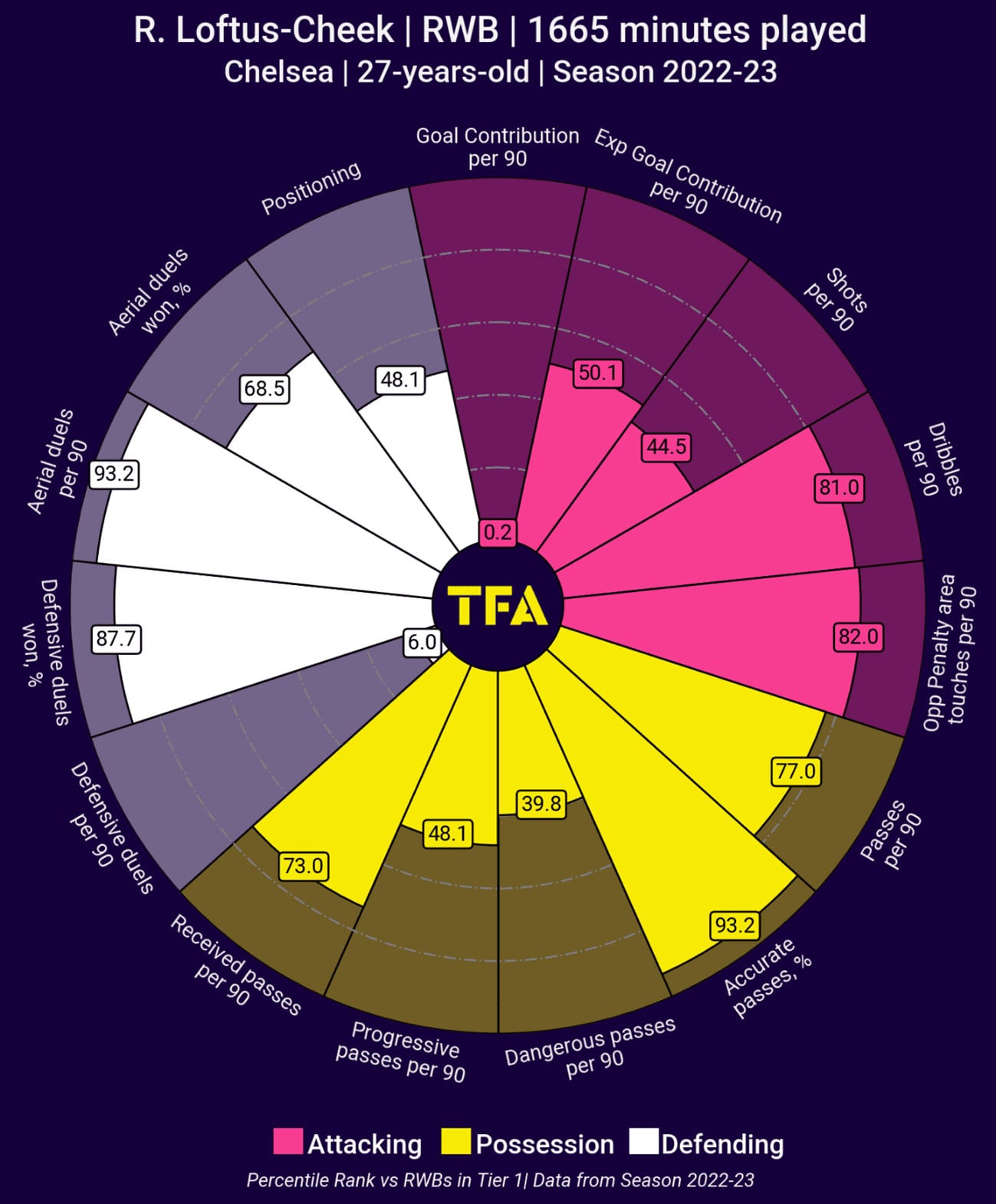
As we can see in the radar above, Ruben is a balanced player who can be strong both offensively and defensively. Let’s then try to dissect his main characteristics.
At Chelsea, the Englishman played as a right-centre midfielder as his main functions were to be a linking element in the build-up phase but, above all, to support the team’s offensive workload. We foresee him playing on the pitch’s centre-right side, whether by acting in a double-pivot or further up the pitch.
The above radar verifies such a statement by showing that Ruben ranked in the 82nd percentile on touches inside the opposition’s box. However, this offensive availability can create space behind his back if his teammates do not cover his positioning.
He’s an endangered type of midfielder due to his physical agility equilibrium, whereas typically, players with his stature lack mobility.
Depending on which partner Ruben is playing with, he can have different functions during the game. For example, if his duo is a more vertical player like himself (Musah, for example), one needs to be more backtracked during the build-up. In the course of our analysis we found out that one of the most common AC Milan moves is the three-man build-up, where one of the midfielders descends and incorporates the backline.
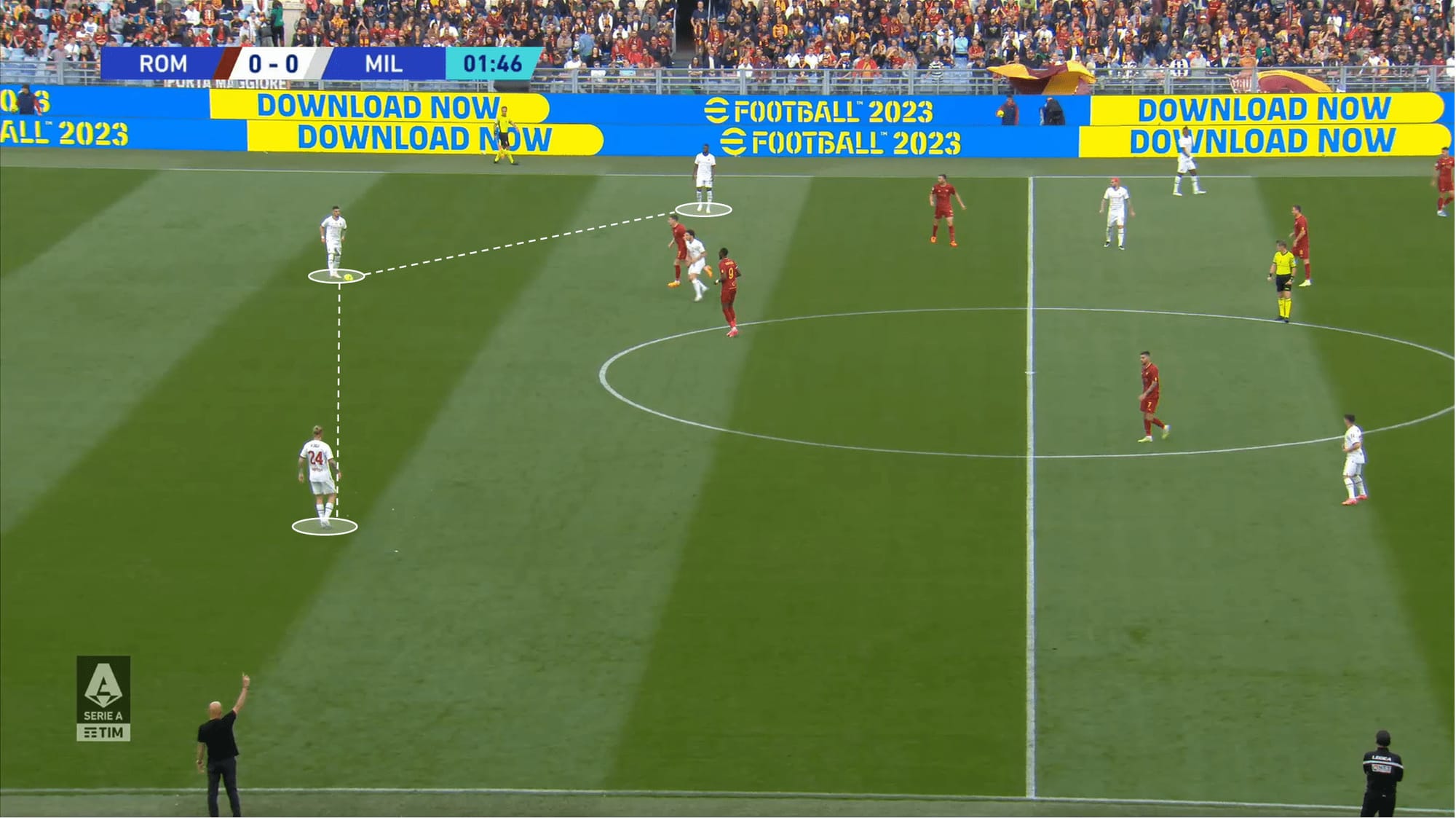
Ruben can not only be decisive by continuously winning duels during the match (ranked in the 87.7th percentile in defensive duels won) but also be an essential element in transitions due to his mobility and speed. His height (1.91 meters) also has a significant impact on his performance, especially in aerial duels. In a physical league like the Premier League, Loftus-Cheek ranked in the 93.2nd percentile on aerial duels disputed and 68.5th in aerial duels won (%).
Yet, in our view, we think that if Ruben wants to establish himself in Pioli’s first team, he needs to work on his defensive availability. He ranked in the 6th percentile in defensive duels disputed per game. This is a low stat for a midfielder, especially if he wants to replace Sandro Tonali or temporarily Bennacer successfully.
His technique is also one of his best characteristics, where he can easily dribble past opponents and repeatedly use his weaker foot. He’s a natural ball carrier and uses his physique and technique to successfully dribble the ball from a more down zone of the pitch into the final third. He ranked in the 81st percentile on dribbles per 90 minutes for Chelsea last season.
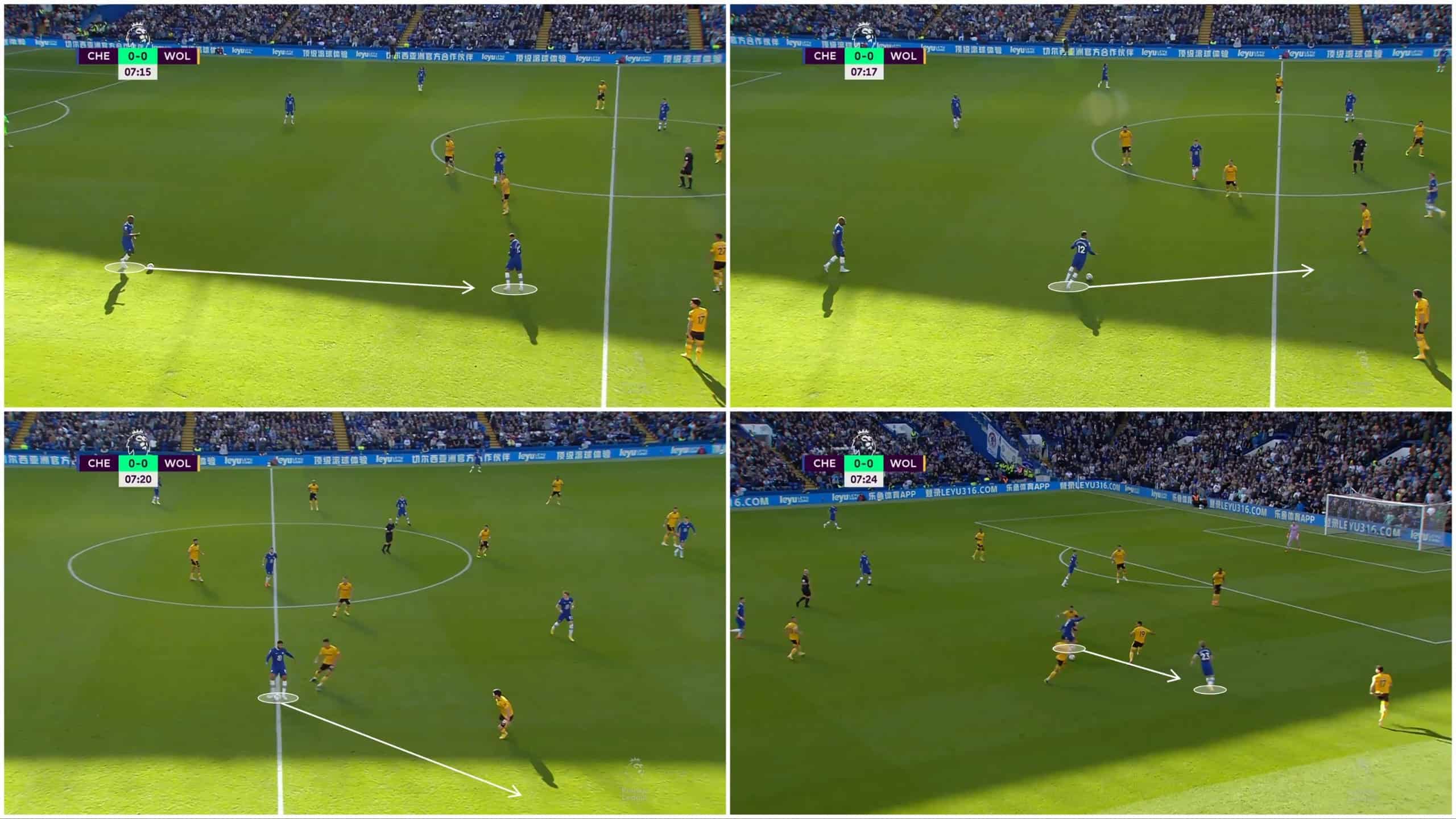
Finally, concerning his decision-making, Loftus-Cheek is a mature player who ranked in the 93.2nd percentile on accurate passes (%).
He’s not a player characterised by breaking lines or making that final pass into the final third but as a ball carrier with high offensive involvement.
Christian Pulišić
Punished with injuries during the years, Pulišić was in a descending trajectory at Chelsea and started to lose his place at the club. As it goes, the board decided to sell him under his market value for around €20.00m to Pioli’s AC Milan.
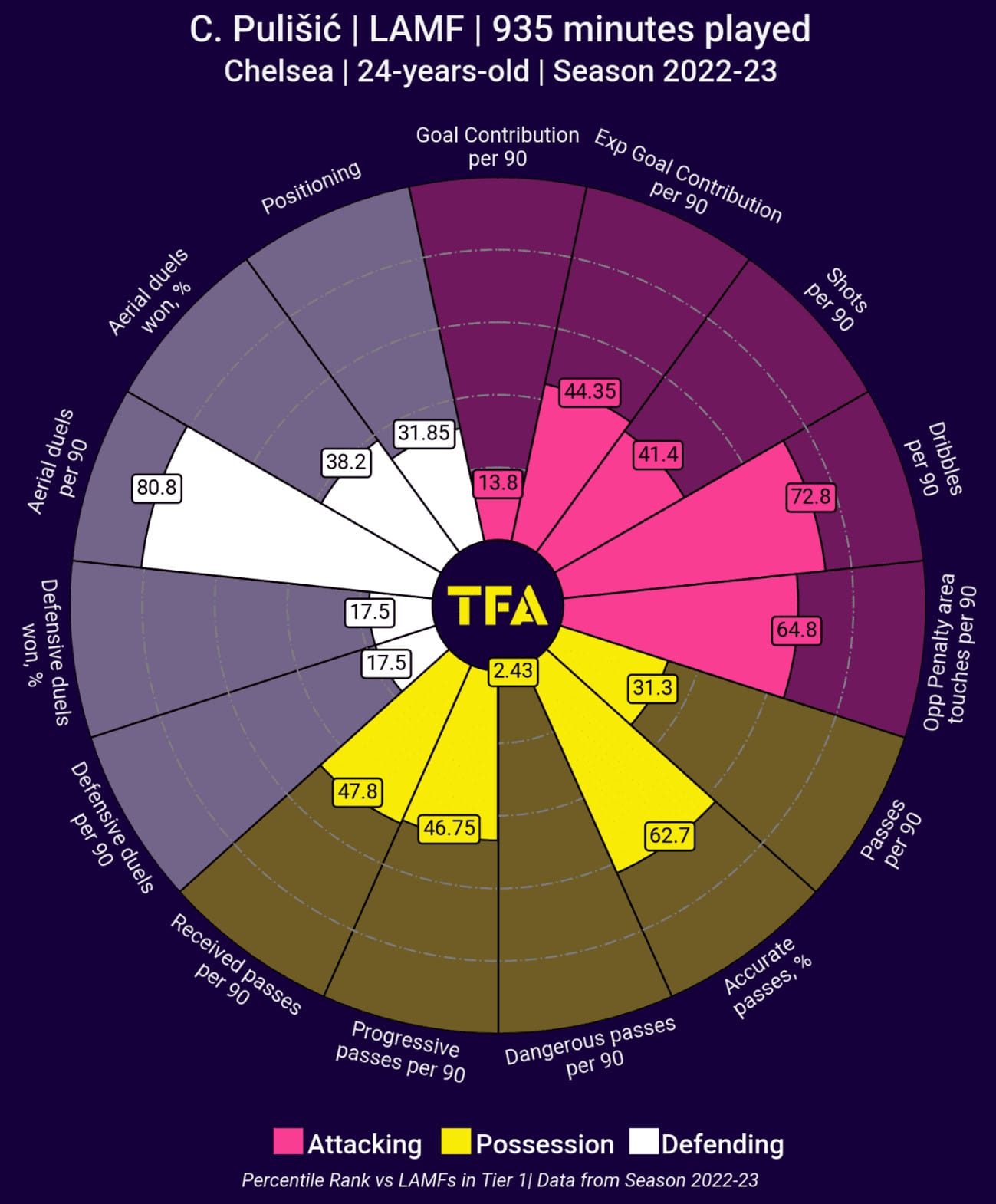
At the “Rossoneri,” we expect to see Pulišić disputing the place in the initial line-up with Chukwueze as a right-winger since Rafael Leão plays preferentially as a left-winger. Moreover, he can also play right behind the centre forward. Pioli can use his characteristics and position him as an offensive midfielder if Milan are playing in a 4-2-3-1, just like Díaz.
Generally, the North American is an agile and talented winger whose main functions at Chelsea were to upset the opposition by the flank with great combinations and his distinguished dribble.
Let’s start with his relationship with what surrounds him. Initially, he likes to be positioned wide open even when the ball is on the opposite corridor.
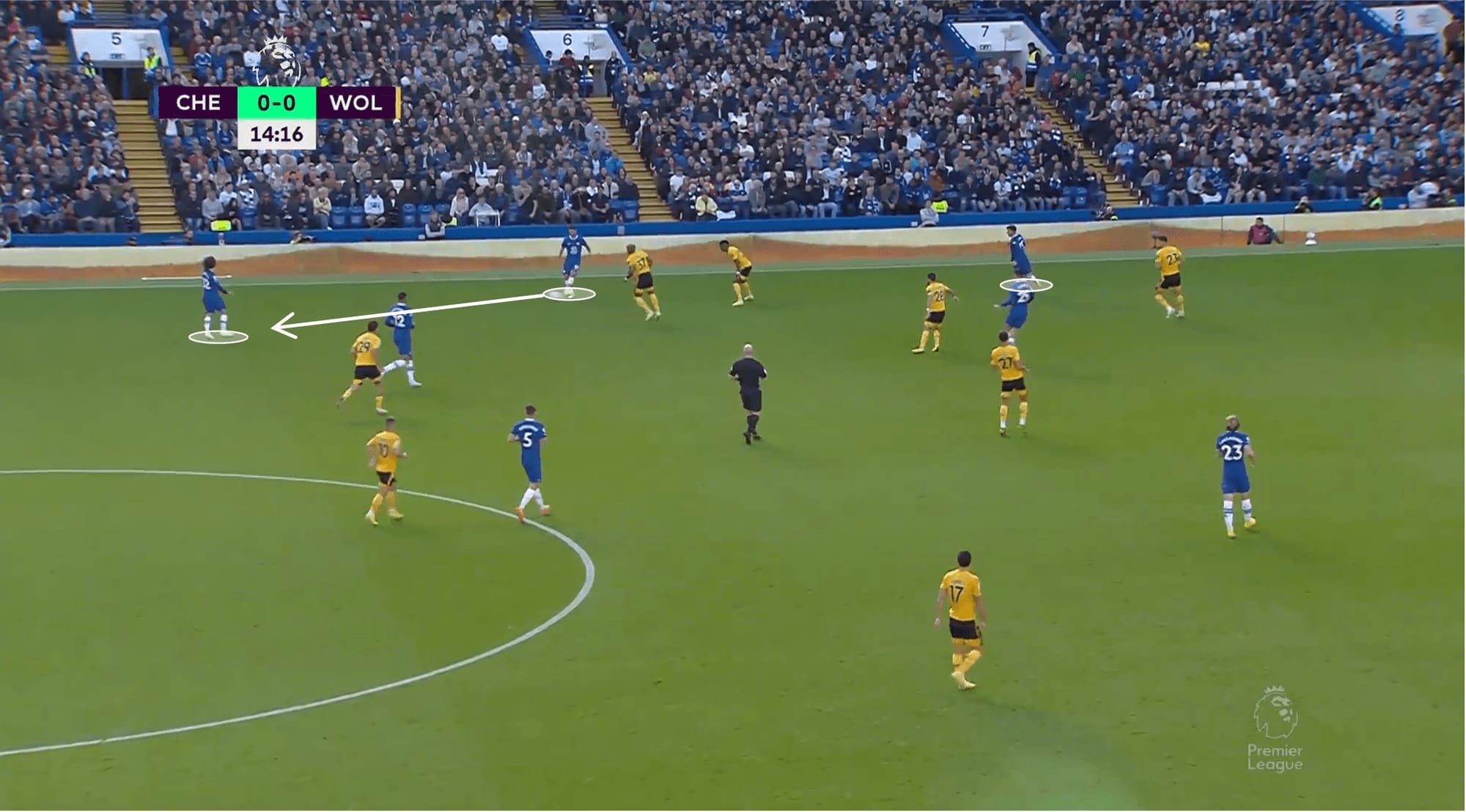
Afterwards, he decides his positioning with his teammates’ off-the-ball behaviour, where he can go inside if the width is occupied or vice-versa.
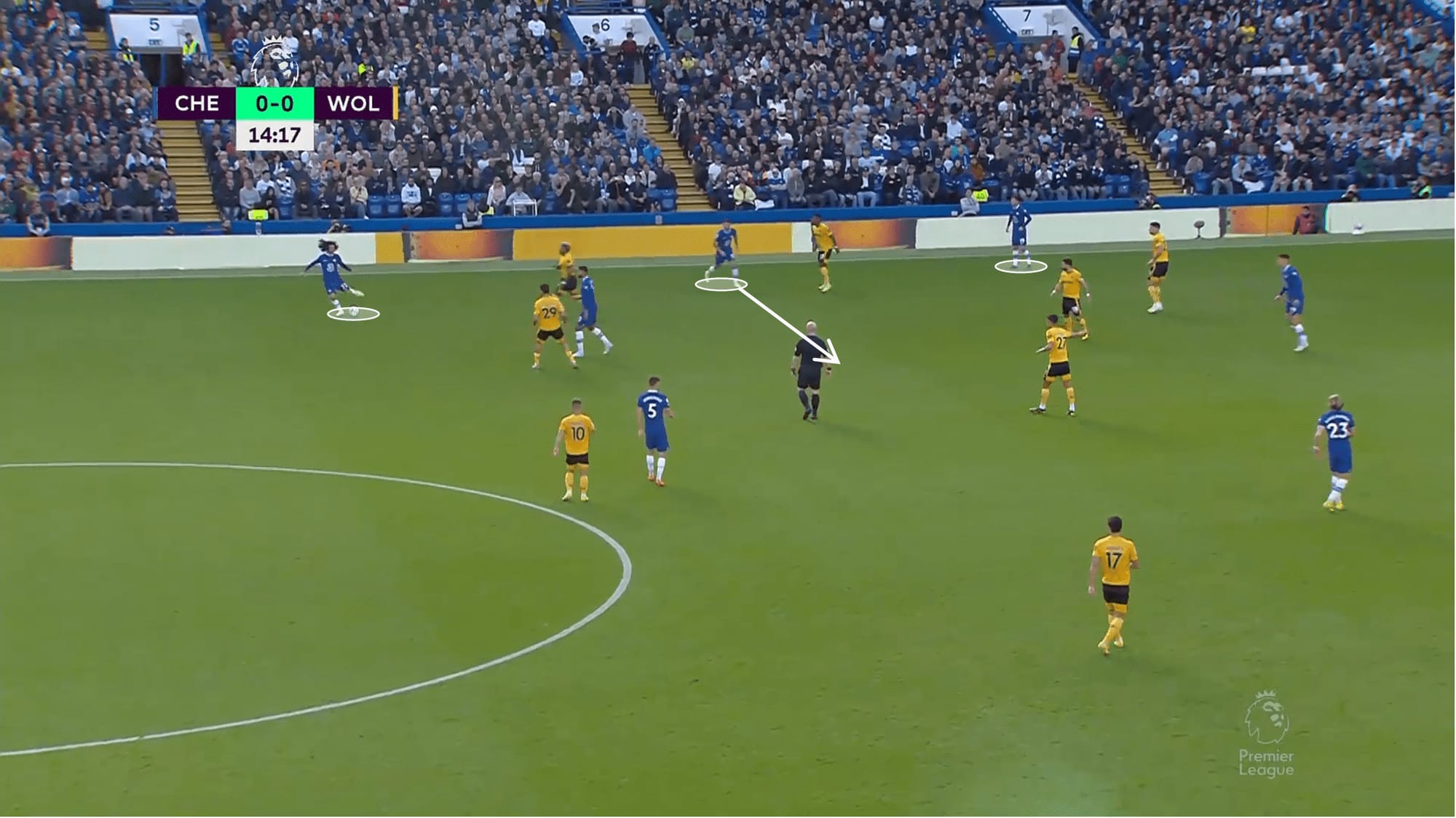
With the ball on his feet, he has decent decision-making, characterised by his objectivity and good vision.

He is strong in the 1v1 and takes advantage of his agility and creativity to progress at the flank. Ideally, the dribble often has two outcomes, or the player seeks a better teammate after such an individual action or decides to finalise the play by himself.
As we see it, Christian decides quite well in these situations, where the outside-inside dribble is one of the most common plays during his performances.
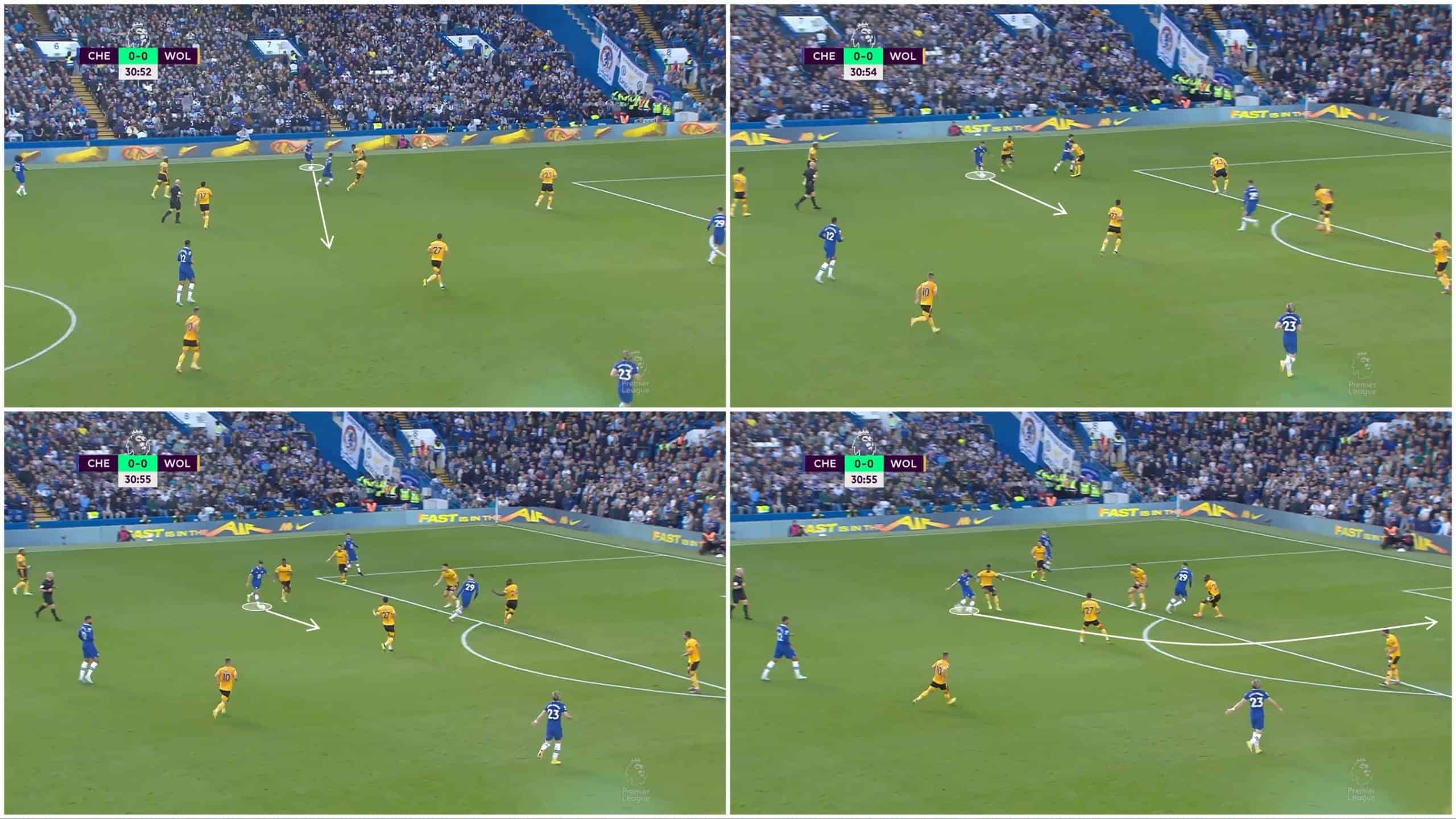
Even though such a movement can be compromised, since he will most likely play by the right flank, we are convinced that Pulišić will find other reasonable alternatives to his game.
We foresee Pioli exploring Christian’s inside-game capacities as he did with Brian Díaz. In an initial phase, he could give solution inside and down, giving the deepness and width to the right-back, most likely Calabria.
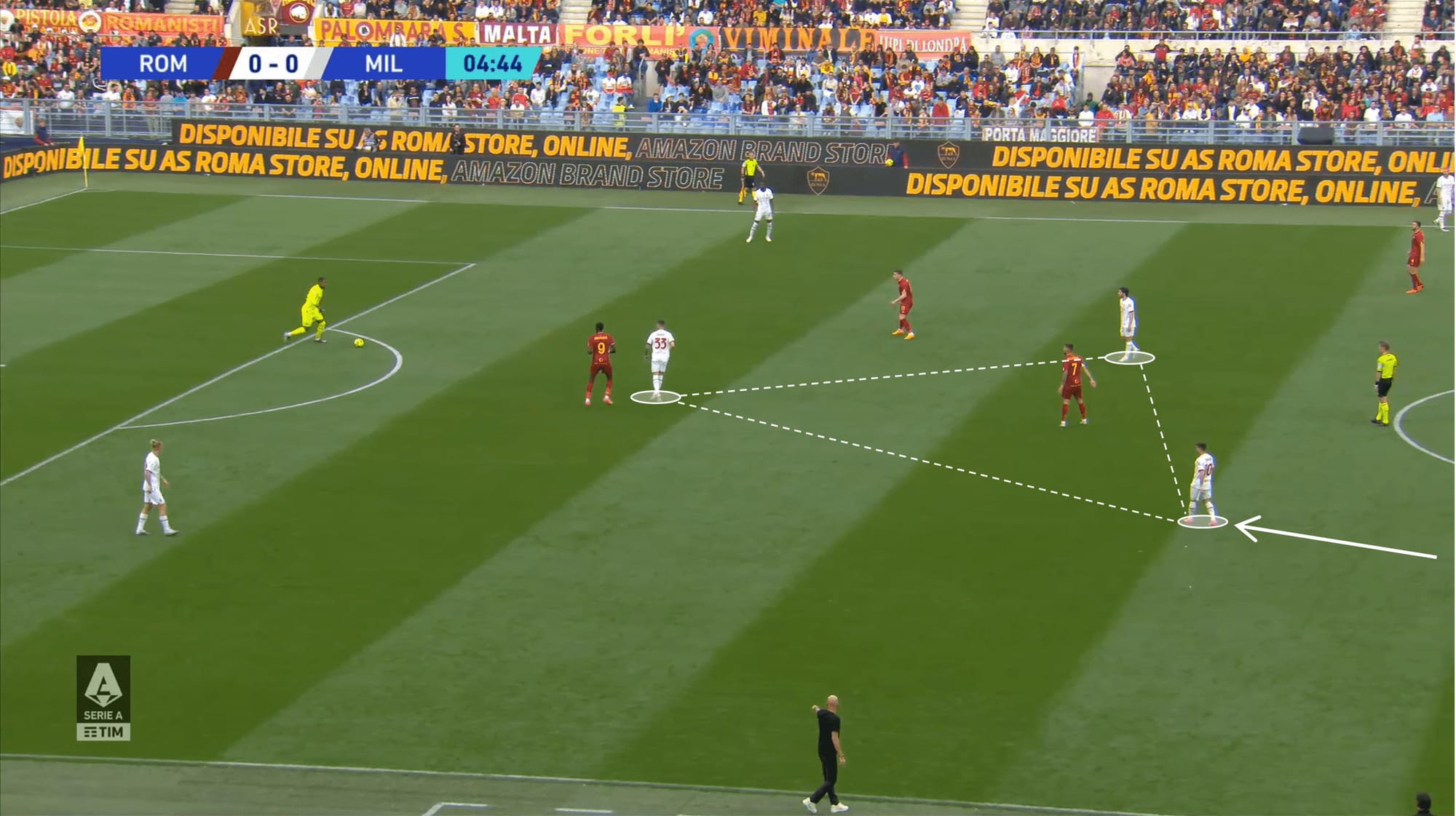
In our opinion and following the above radar, it is perceptible that, similarly to Ruben Loftus Cheek, Pulišić needs to improve his defensive awareness. He ranks in the 17.5th percentile on both duels disputed per game and duels won (%). Although Rafael Leão is also undeveloped in such defensive stats, Pioli balances the system by having a more intense and aggressive right-winger like Alexis Saelemaekers or Ante Rebić, who constantly descends on the pitch.
Besides his intensity, a physical improvement would significantly enhance his offensive and defensive actions. He shows some difficulty in holding his opponents’ charges while dribbling. Yet he demonstrated a colossal explosion and agility capacity, which are crucial to his game.
Samuel Chukwueze
In one of his best seasons, in individual terms, Samuel scored 13 goals and assisted 12 times for Villarreal. AC Milan were vigilant to this Nigerian talent and brought him for €20.00m in this summer transfer window, which, in our view, was a bargain considering his consistency at the Spanish side.

This Nigerian is characterised by his technicity and capacity to upset the opponent in the 1v1 through his outstanding dribble and technical skills. Referring to the above radar, we can see that he ranked in the 86.3rd percentile on dribbles made per game.
Similarly to Christian Pulišić, the Nigerian uses his dribble as his primary weapon and creates both in the outside and inside parts of the pitch. His assists were mostly conducted in the corridor, where after Samuel dribbles some of the opponents, he lifts his head and crosses to the available teammate.
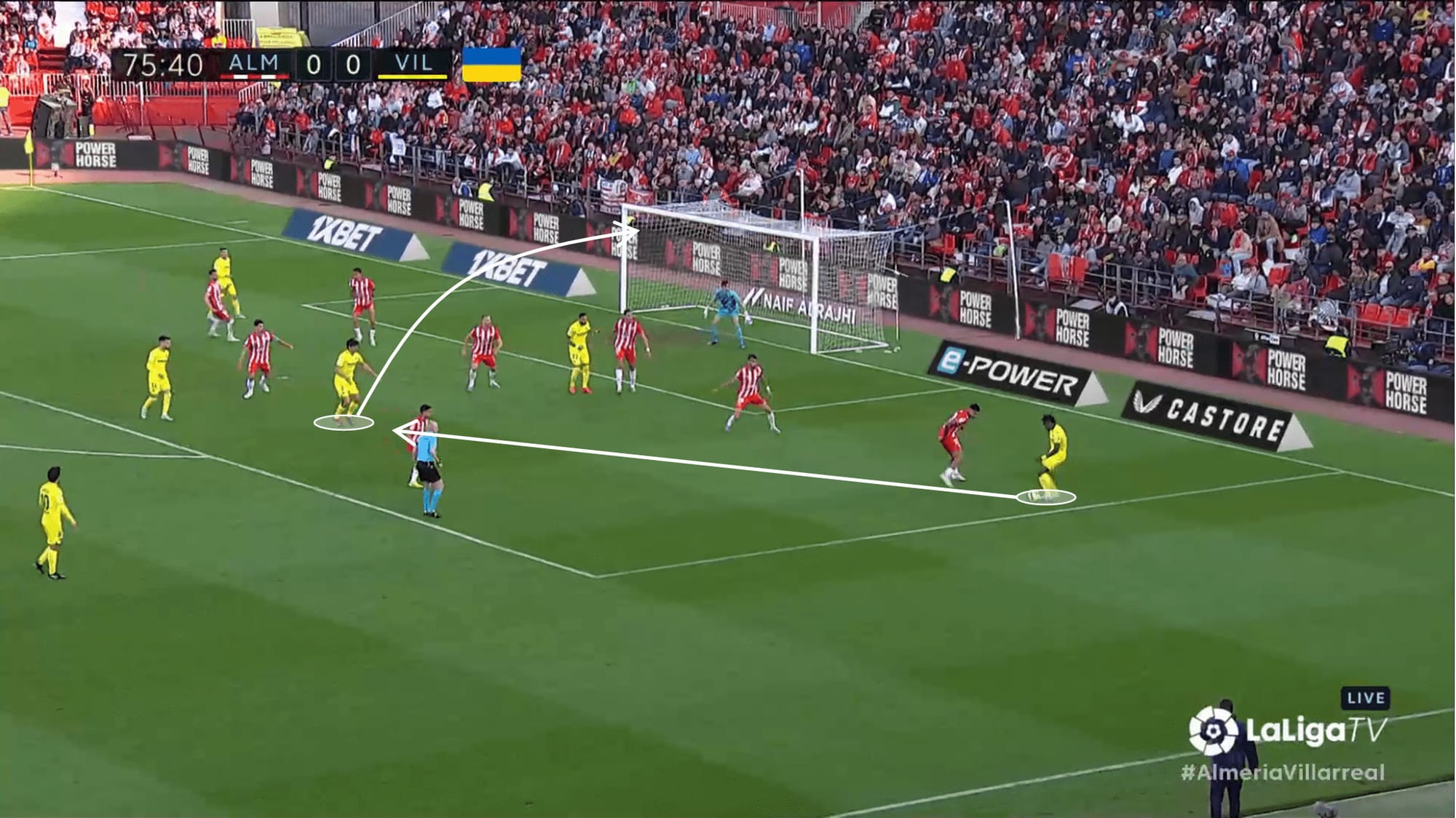
We expect great runs down the wing, with him finding teammates like Giroud and Rafael Leão in the box to score.
Again, referring to the radar, it is possible to see that he ranks in the 90.07th percentile in dangerous passes per game, which proves such an impact on assists.
However, this player often explores more interior spaces, especially between the lines.
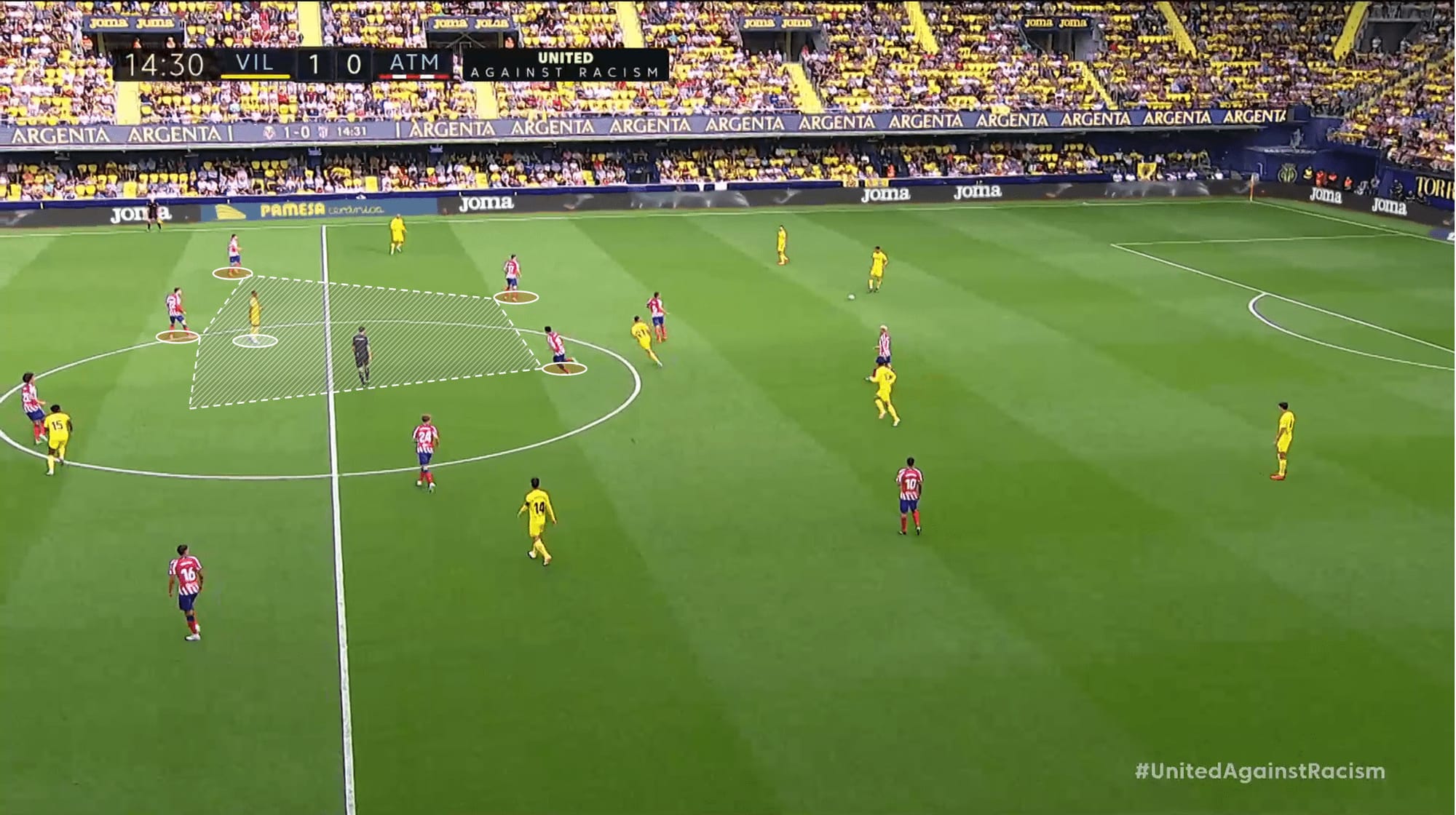
A high self-confidence player who is willing to risk the dribble and the shot, ranking in the 65th percentile on shots taken per 90 minutes. When the ball is on the opposite flank, he wisely positions himself at the entrance of the area, waiting to take a shot.
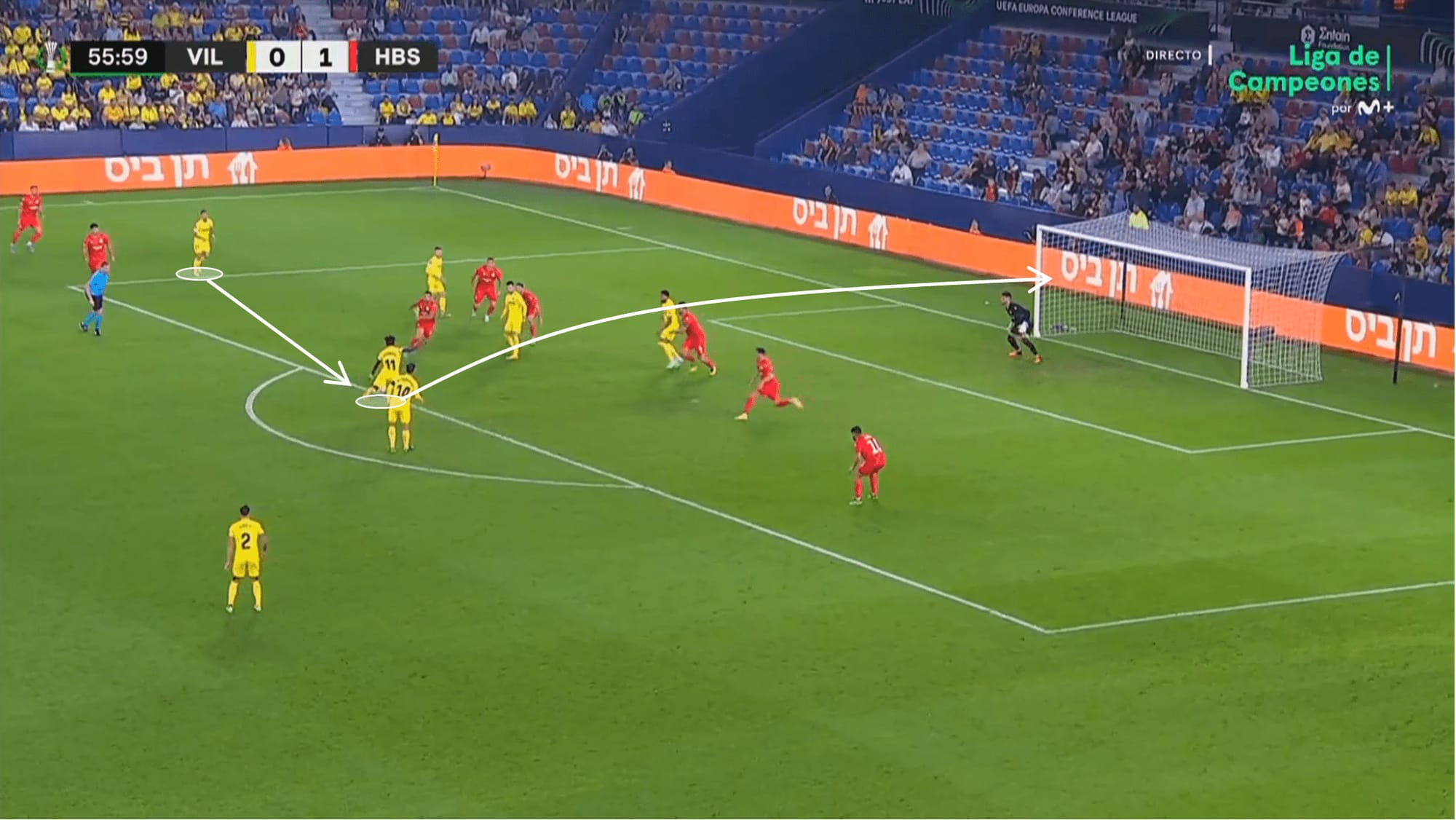
Under Quique Setién, Chuk had some freedom concerning his defensive positioning where his offensive workload seemed to compensate for such insufficiency. Having that said, he ranked in the 7.6th percentile in duels disputed, which is a clear sign of the defensive disconnection of the Nigerian. This will surely be one of the points where Pioli will try to insist since it will be challenging to defend without the continuous support of the wingers.
Another stat that evidences Chuk’s lack of aggressiveness is the number of yellow cards received last season: two. Although it isn’t an enlightening statistic, it indicates some lack of intensity.
Finally, we also would like to enhance Samuel’s on-the-ball focus during the game, where, in some circumstances, Chuck seemed to be unplugged, leading to some bad decision-making. The radar is helpful to confirm it, where the Nigerian ranked in the 47.3rd percentile on accurate passes (%). Yet, this does not necessarily mean the winger usually has poor decision-making. On the contrary, he greatly influenced Vilarreal’s offensive success and goal contribution.
Yunus Musah
With his third season for Valencia finished, the North American Yunus Musah was signed by AC Milan for €20.00m. He was an exciting promise who disputed 108 official games for the Spanish side and who was becoming an essential key for the team’s puzzle.
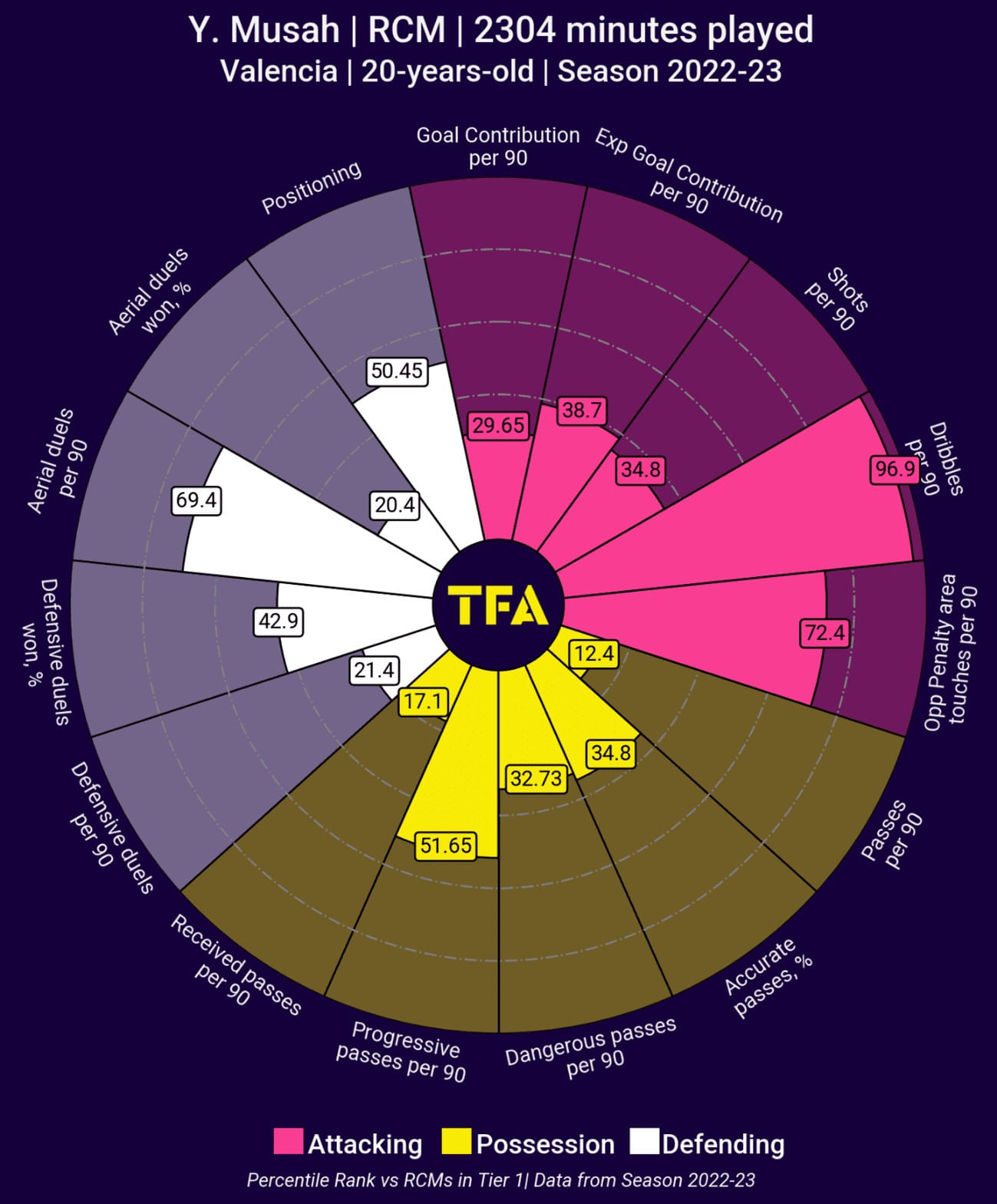
At Valencia, this midfielder played predominantly as a right-centre midfielder, yet he also performed as a right midfielder. Under Stefano Pioli, we foresee him competing with Ruben Loftus-Cheek for the right-centre midfield position.
Looking at the above radar, the dribble stands out, where he ranked in the 96.9th percentile per game. In fact, as we will detail further, Yunus feels comfortable carrying the ball from a more down zone of the pitch into the final third due to his physical and technical skills.
Concerning his positioning, the 20-year-old has good tactical awareness and usually is deep, seeking the space between the lines. This happens when the winger is using the full width. However, if the winger is inside, he immediately occupies the space near the touchline.
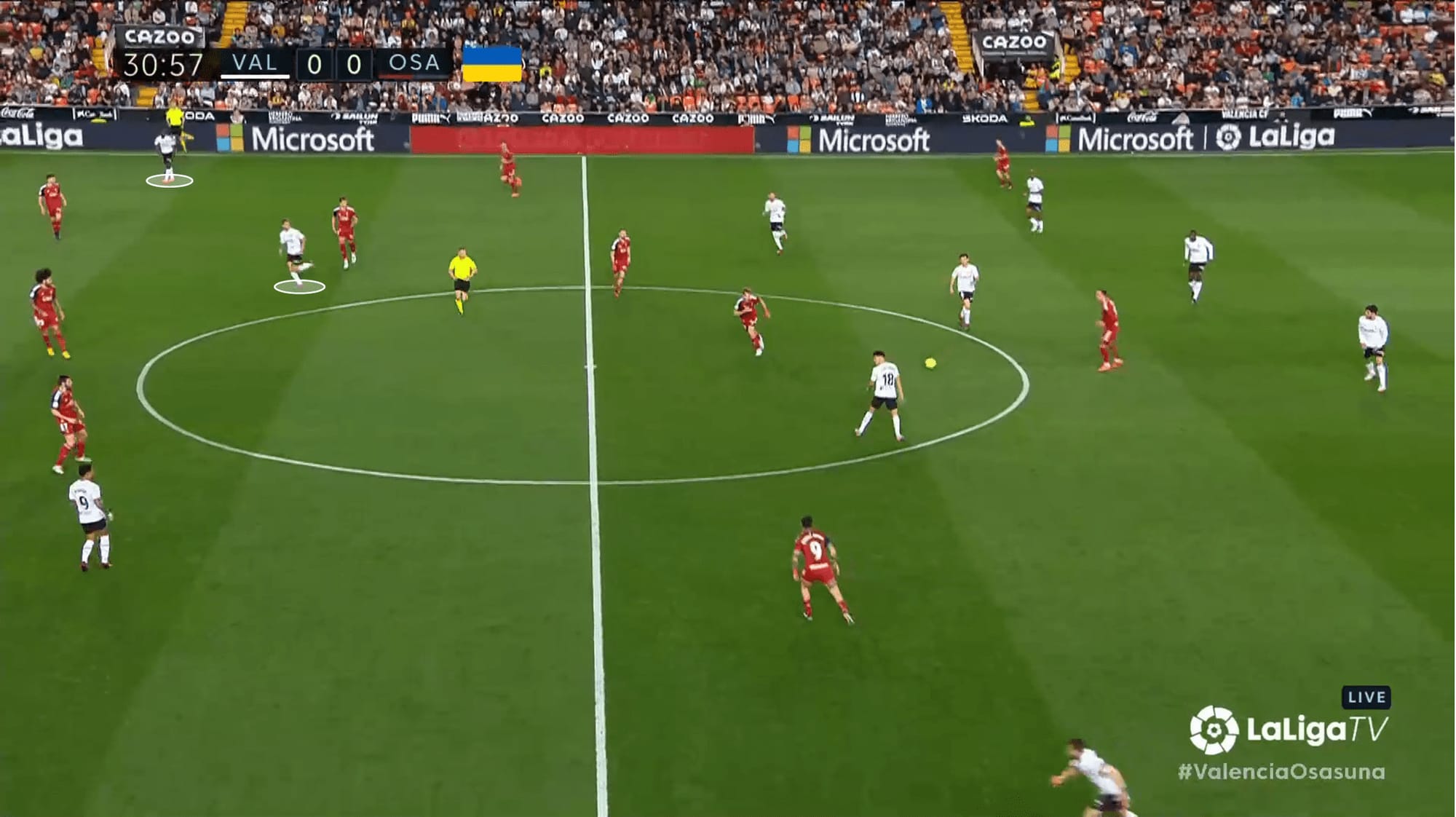
Musah has shown decent mobility on and off the ball, and right after a pass is made, he instantly seeks another free space to occupy.
Moreover, Yunus also attacks the space right behind the back line, especially when the ball is uncovered.
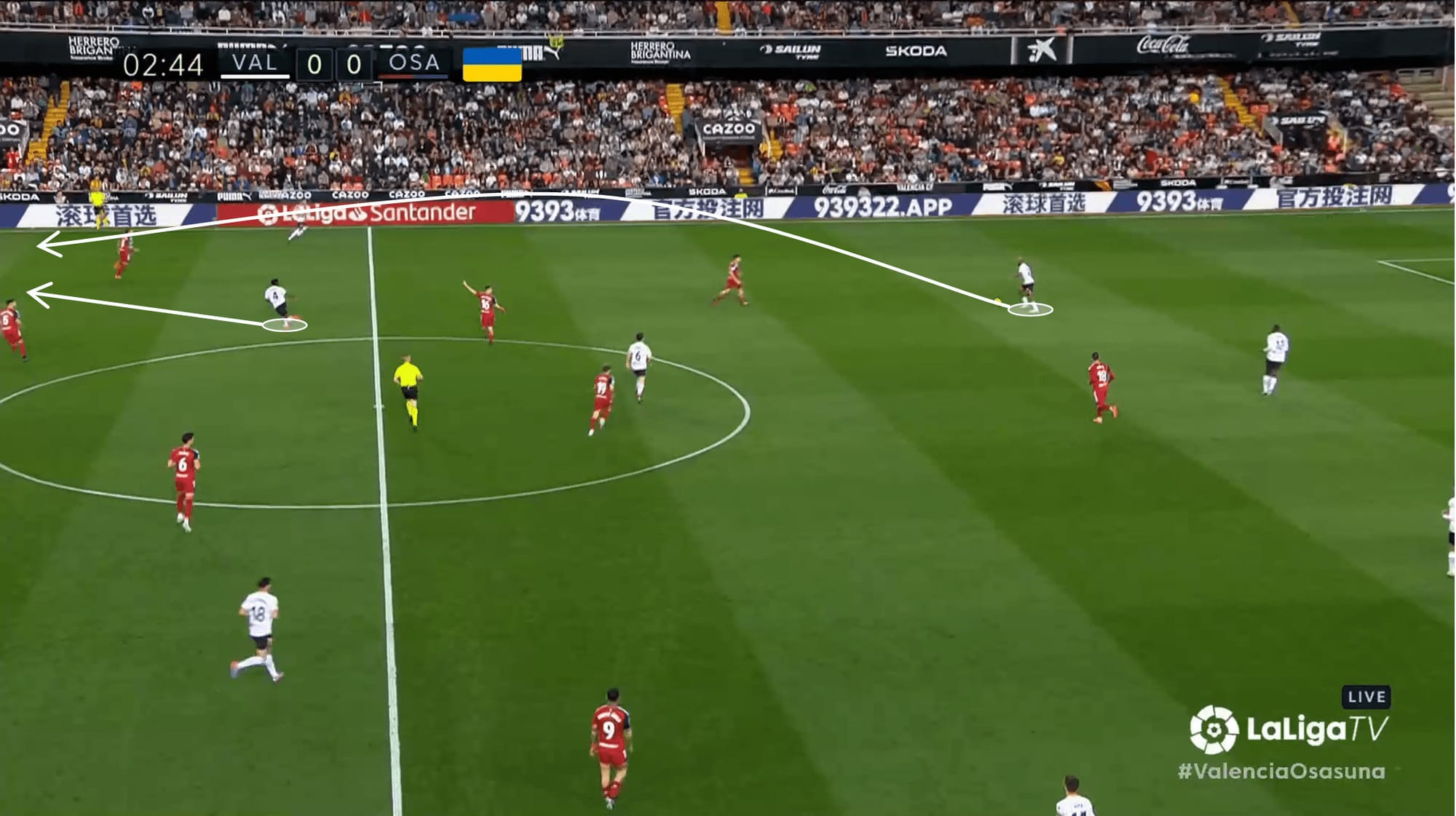
Although he also has a strong presence in the box (72.4th percentile), he still needs to improve in making a difference in the last third, where he directly contributed only eight times during these three seasons.
At 20 years old, the midfielder already has a considerable physical predominance, especially in terms of muscular mass, which turns out to be an advantage in his game. One of the game aspects that reveals such physical prevalence is during the dribble, where Musah is an explosive player and strong enough to hold the opponent’s charge.
Defensively, he understands what the game is asking, and we found interesting his compensation when the teammates are out of their normal positioning.
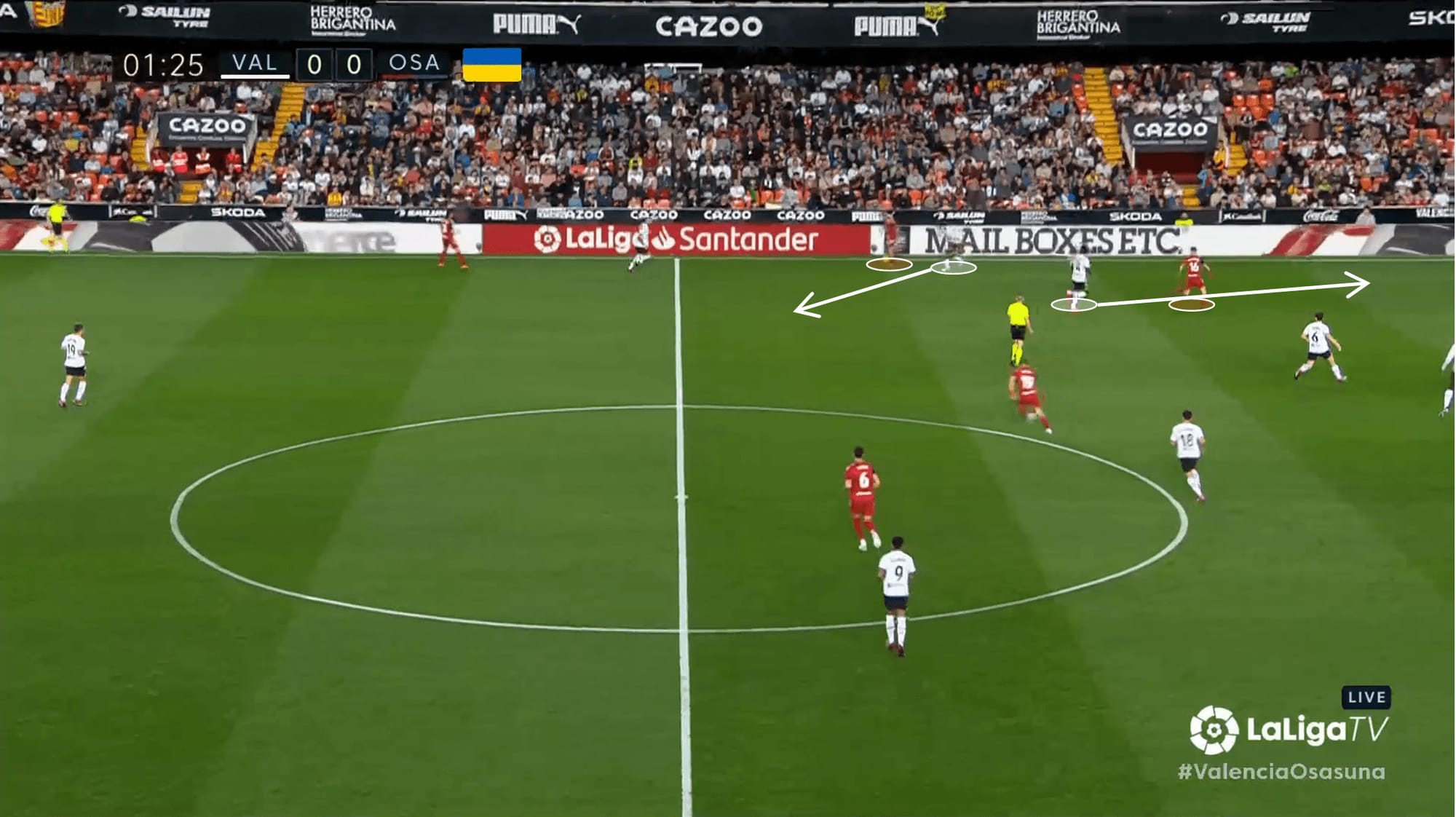
Yet, again, referring to the available data, it is evident that he can improve his defensive tasks. In fact, he could expose himself while defending by having more duels (ranked in the 21.4th percentile) and improve his effectiveness in such tasks (ranked in the 42.9th percentile).
Tijjani Reijnders
The third midfielder signed was the Dutch Tijjani Reijnders, who was under contract with AZ Alkmaar. After an exceptional season with seven goals and 12 assists, the 24-year-old was sold to AC Milan for around €19.00m.
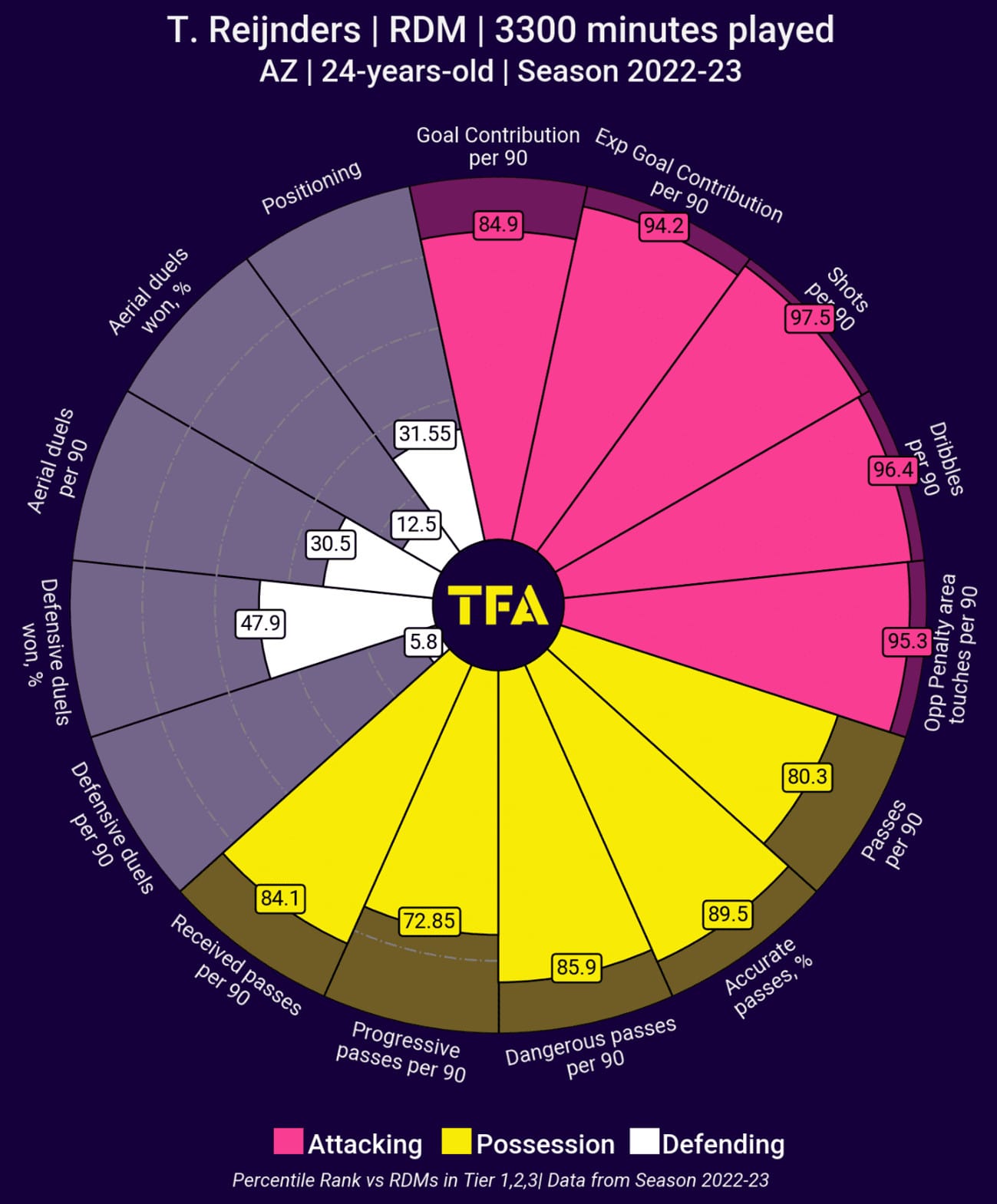
Tijjani is a player characterised by his quality while his team is in possession, essentially due to his tactical knowledge and outstanding technical attributes. He is a refined player who shows unique details during the game and has a powerful weapon: his shooting.
Even though he’s a player who significantly impacts his team’s build-up, he ranked in the 84.9th percentile on goal contribution per 90 minutes last season. Additionally, it is also visible that his shooting percentile is also way above average (96.4th).
It is clear that in Serie A, this player will not have the same space to create as he has in the Eredivisie, yet it still shows his extraordinary capacity to create and deliver offensively. Besides that, it’s also important to note that many of his shots are taken from outside the box.
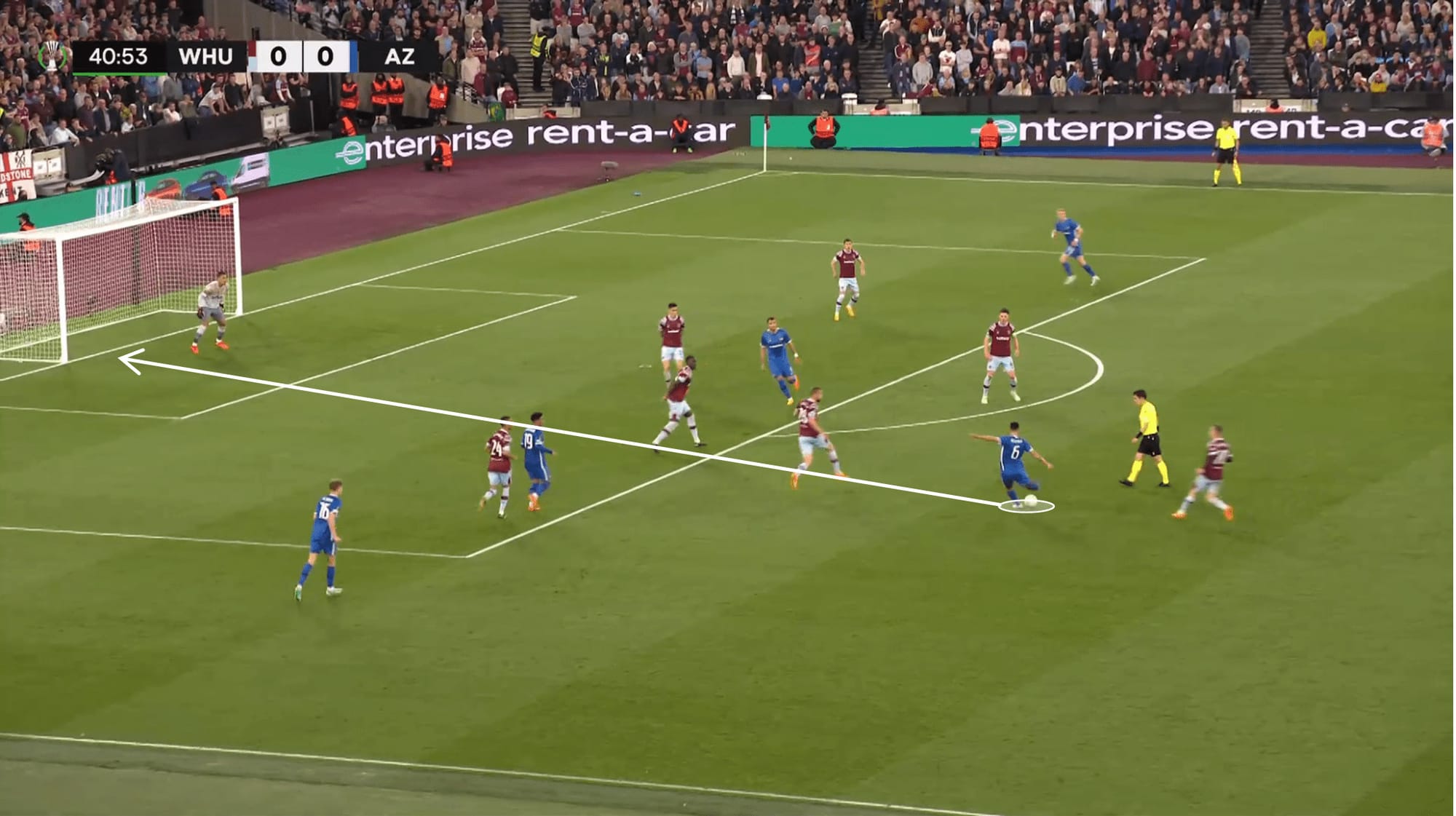
Not only is he quite involved in the last third of the pitch plays but also in the match’s early stages. In fact, he was a critical piece of the puzzle during the build-up due to his passing capacity and willingness to give solutions to the centrebacks.
In addition to verifying such an assumption, the data shows that he ranked in the 84.1st percentile on received passes and in the 80.3rd on passes made per game.
His shooting demonstrates his top technique, technical movements and other factors. Although, in our view, three main game aspects dissect a player’s technique rate: the reception, the pass and the dribble, and Tijjani does quite well in all of them.
Concerning his pass, he has mature decision-making by ranking in the 89.5th percentile on passing accuracy. He could be a player with a high passing effectiveness rate but in a low-risk approach, but it’s not the case where he ranked in the 85.9th percentile on dangerous passes made per game.
He seems to understand where and when to seek a new space to occupy, and still in the build-up, he likes to be right behind the attackers and suddenly make an approximation move near the centreback.
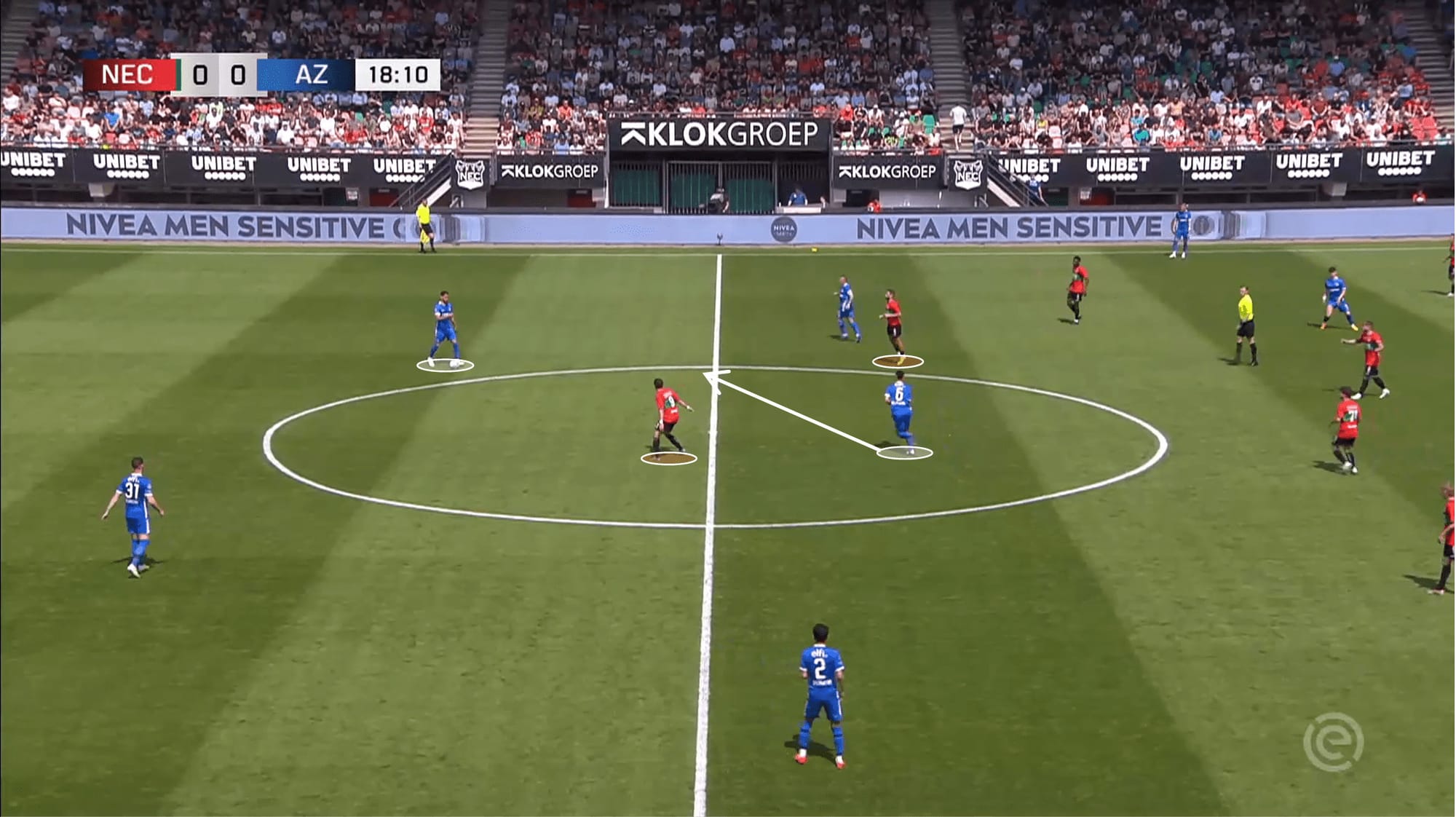
This unpredictableness misguides the opposition’s pressing plan; in these cases, he receives the ball with space and time to decide. Again, these situations will undoubtedly be less common as soon as he plays against Serie A sides.
He usually receives the ball with the correct body shape, oriented to the opposition, which considerably eases the linking process. In most cases, he has the quality to decide well, varying his actions by finding teammates in more interior zones or, if the game is asking, exploring the full-backs using the width.
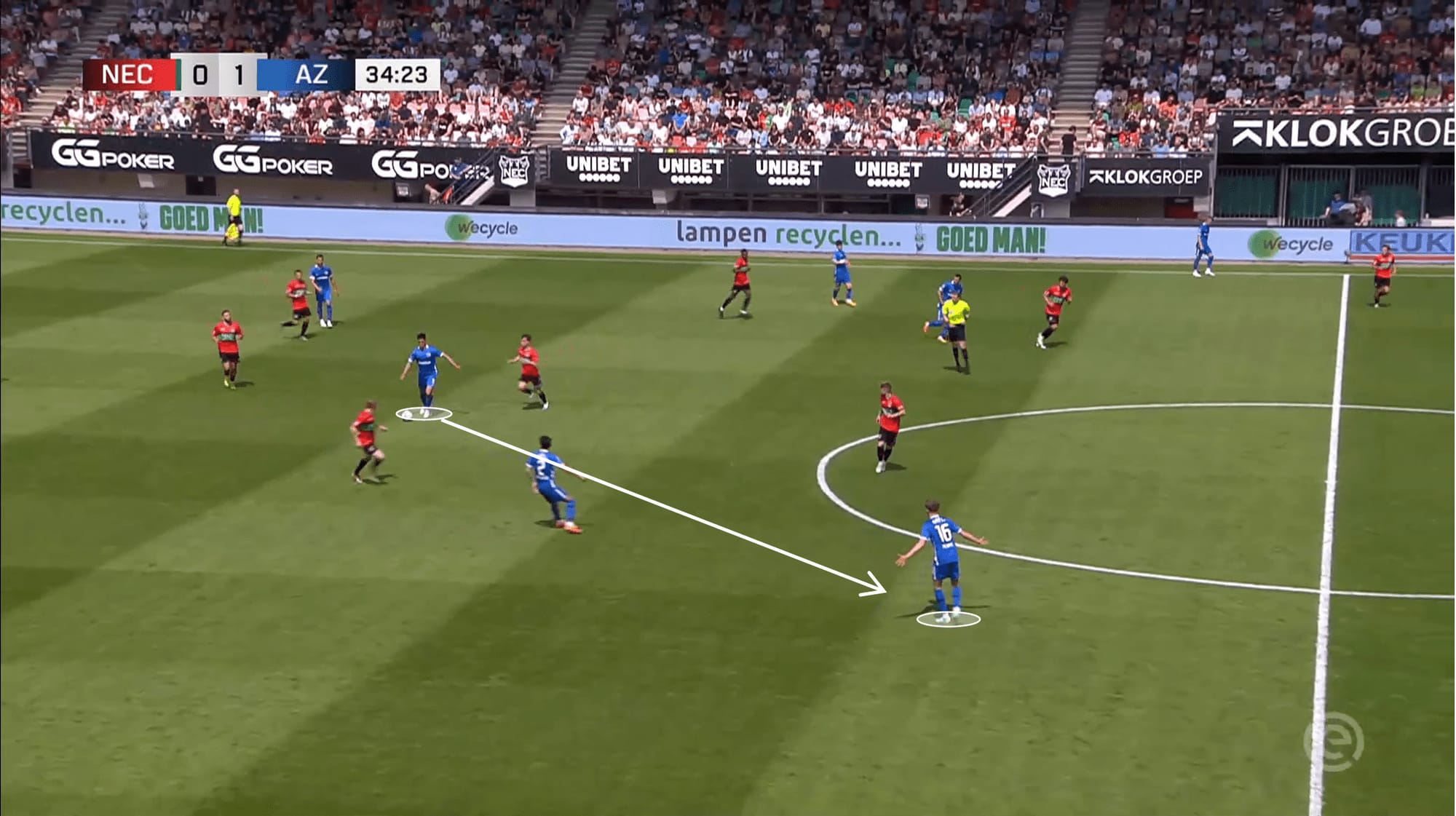
His main downside is related to the defensive phase of the match. He ranked in the 5.8th percentile in defensive duels disputed, which is more than a clear sign that the Dutchman needs to go after more duels, especially off the ball.
He’s also not a top-speed player, which can condition his game in some situations, especially in offensive and defensive counterattacks.
Conclusion
AC Milan has reinforced themselves quite well this summer, and in our opinion, they have found suitable replacements for two big departures: Sandro Tonali and Brian Díaz.
Regarding the signings aimed at Díaz’s replacement, we have Christian Pulišić and Samuel Chukwueke. We explained their main strengths and defensive weaknesses, which should be improved to make AC Milan a more cohesive team.
Finally, to replace Tonali and Benacer’s injury, the “Rossoneri” signed Ruben Loftus-Cheek, Yunus Musah and Tijjani Reijnders. After briefly describing each player, we conclude this scout report saying that Ruben and Tijjani are the players with higher preparation to assume the initial line-up. However, Musah is a highly talented youth player with a bright future in Pioli’s hands.

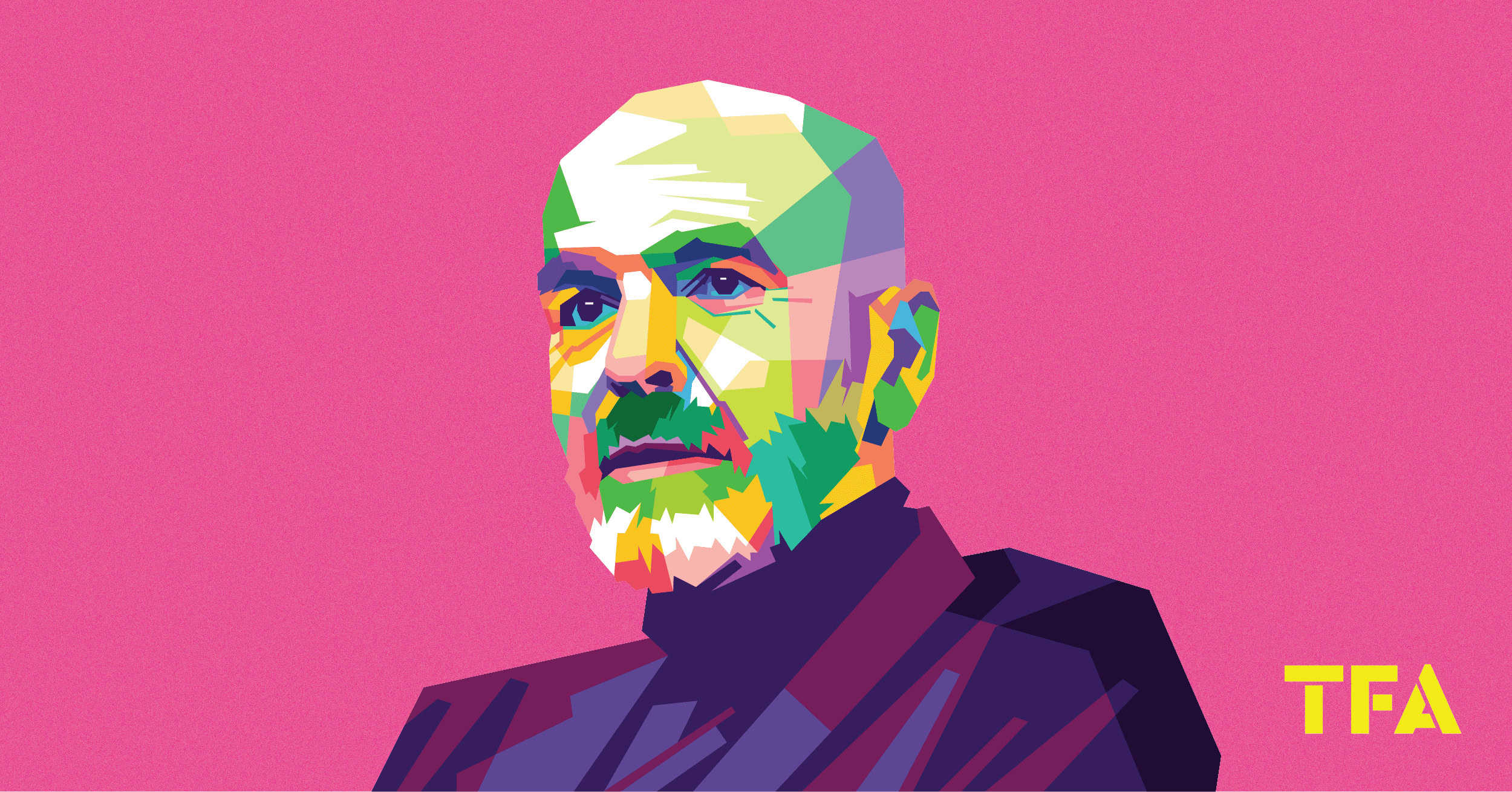




Comments